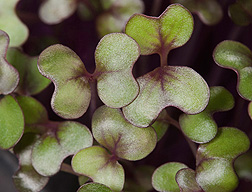| Read the magazine story to find out more |
|
|
|
|
Science Confirms - You Really Should Eat Your Brassica
April 3, 2017
U.S. Department of Agriculture (USDA) scientists have determined your Mom was right. You should eat your Brussel sprouts, kale, cabbage and 27 additional varieties of Brassica microgreens. That declaration comes following the identification of phytochemicals, vitamins and minerals in all members of the Brassica family that are important to our health.
Yaguang (Sunny) Luo, a food technologist at the Food Quality Laboratory in Beltsville, Maryland, led a team of scientists that conducted the mineral analyses of the Brassica microgreen varieties. Eton Codling, a research agronomist at the Adaptive Cropping Systems Laboratory, also in Beltsville, and Zhenlei Xiao, a postdoctoral researcher, collaborated with Luo. Both laboratories are part of USDA's Agricultural Research Service (ARS).
Microgreens are the young seedlings of vegetables and herbs. They are harvested with the seed's original leaves intact, very soon after these first true leaves emerge. The Brassica microgreens analyzed in this study included arugula, broccoli, kale, radish, red cabbage and wasabi.
Essential minerals are a class of nutrients important for human health that are obtained from dietary sources. There are two groups of these essential minerals: microelements (also known as "trace elements," such as iron, zinc, copper and manganese) and macroelements (such as calcium, magnesium, phosphorus, potassium and sodium).
These elements play crucial roles in various biological processes for both plants and animals. In humans, deficiencies can cause metabolic disorders and organ damage leading to diseases and even death.
Luo and her research team found that mineral concentrations in microgreens varied by species and variety. The most abundant macroelement found in the microgreen samples was potassium, followed by phosphorus, calcium, magnesium and sodium. Potassium values were highest in wasabi microgreens and lowest in daikon radish microgreens. Savoy cabbage microgreens had the highest calcium levels.
Microgreens are an emerging class of specialty fresh produce which have gained popularity with chefs and consumers, and positively impact diets, according to Luo.
Read more about this research in the April 2017 issue of AgResearch.
For more information contact Sharon Durham, ARS Office of Communications.
The Agricultural Research Service is the U.S. Department of Agriculture's chief scientific in-house research agency. Daily, ARS focuses on solutions to agricultural problems affecting America. Each dollar invested in agricultural research results in $17 of economic impact.

